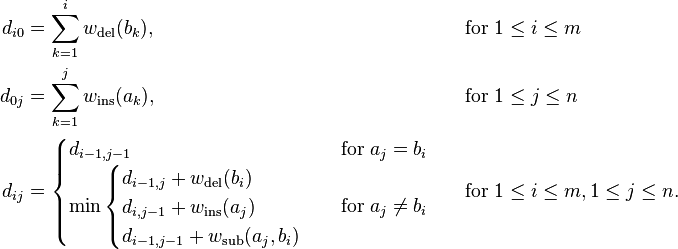Edit Distance
Given two words word1 and word2, find the minimum number of steps required to convert word1 to word2. (each operation is counted as 1 step.)
You have the following 3 operations permitted on a word:
a) Insert a character
b) Delete a character
c) Replace a character
Hide Tags
Hide Similar Problems
眼界不够,看了wiki 才知道这个问题还是有来头的。
先说题目本身,解完了再说它的渊源。
把两个字符串分别放在 DP 的矩阵横向/纵向的两个邻边,
如果在某个格子(x,y)从两个字符串里取到的字符不同, 则可能要进行三种操作:插入,删除,替换。
仔细观察可以知道,插入,删除,替换分别对应动态编程中的向右,向下,向右下:
向下说明要在纵向的字符串里多跳过一个字符,然后再与横向字符串的下一个比较;
向右则反之,说明要跳过横向字符串里的下一个字符,去跟下下一个字符比较;
也就是说,实际上对一个字符串的删除,等效于对另一个字符串的插入。
而向右下,则是直接把一个字符串中的字符替换成另一个中的字符。
所以此时当前格子的值就是取这三个操作中最小的一个(就是要找最小的嘛),加上当前的操作cost(1);
而如果取到字母相同,很显然无需额外操作,只需要继承之前的结果,也就是 (x-1,y-1)里面的值就可以了。
由此可以得到如下解答:
构建 DP 矩阵 mtx,两字符串居于邻边,但从 1 开始,而不是 0,因为主要的计算在矩阵中间。
注意首行/列分别对应其中一个字符串为空的情形,也就说,步步都插入,所以distance就等于下标:

然后依照规则填写,(1,1)分别对应 b 和 s,所以是取 0 再加 1 = 1;(1,2)则是 1+1=2,(1,3)则是继承 2;……
最终将得到右侧的表格,最后一个格子的 6 就是需要的最小步骤了。
class Solution {
public:
int minDistance(string word1, string word2) {
int len1=word1.length()+1, len2=word2.length()+1;
//use vector get 28 ms, use array get 16 ms.
//vector<vector<int>> mtx(len1, vector<int>(len2, 0));
int mtx[len1][len2]; //will initialize later
for(int x=0; x<len1; ++x)
{
mtx[x][0] = x; //initialization as if word2 is an empty string
for(int y=1; y<len2; ++y)
{
if(word1[x-1]==word2[y-1])
mtx[x][y] = mtx[x-1][y-1];
else
mtx[x][y] = (!x) ? y : //initialization as if word1 is an empty string
//updating minimal distance needed of replace/insert/delete
(1 + min(mtx[x-1][y-1], min(mtx[x-1][y], mtx[x][y-1])));
}
}
return mtx[len1-1][len2-1];
}
};
16 ms.
这个问题的确是有来头的,而且在自然语言处理,拼写检测,生物识别等等领域都是相当重要的。(wiki)
这里的问题是简化过的,实际上还应该带上每个操作的权重,这样就更接近实际问题的处理了:

关于它的算法,DP 有两种,一种是如上面的用二维矩阵,空间是 O(mn),另一种是用两个一维数组来滚动,空间是 O(m+n),
另外还有一种改进的Hirschberg's algorithm,空间只是 O(min{n,m})。
另一个有意思的是,如果把三个操作中的替换去掉,只能增减的话,它就是 LCS (Longest common subsequence) 了;
而如果只是允许替换的话,(对于长度相等的字符串),它实际上就成了Hamming distance。
还有一些其他的演化,例如:
实际的字符串检测中还有一个常见的场景:两个相邻字符位置反了,因此还可以有一个操作,叫做互换(transposition),
另外在 OCR 输出校对的时候,还有 merge 和 split 操作,做一对多的更为复杂的替换。

No comments:
Post a Comment